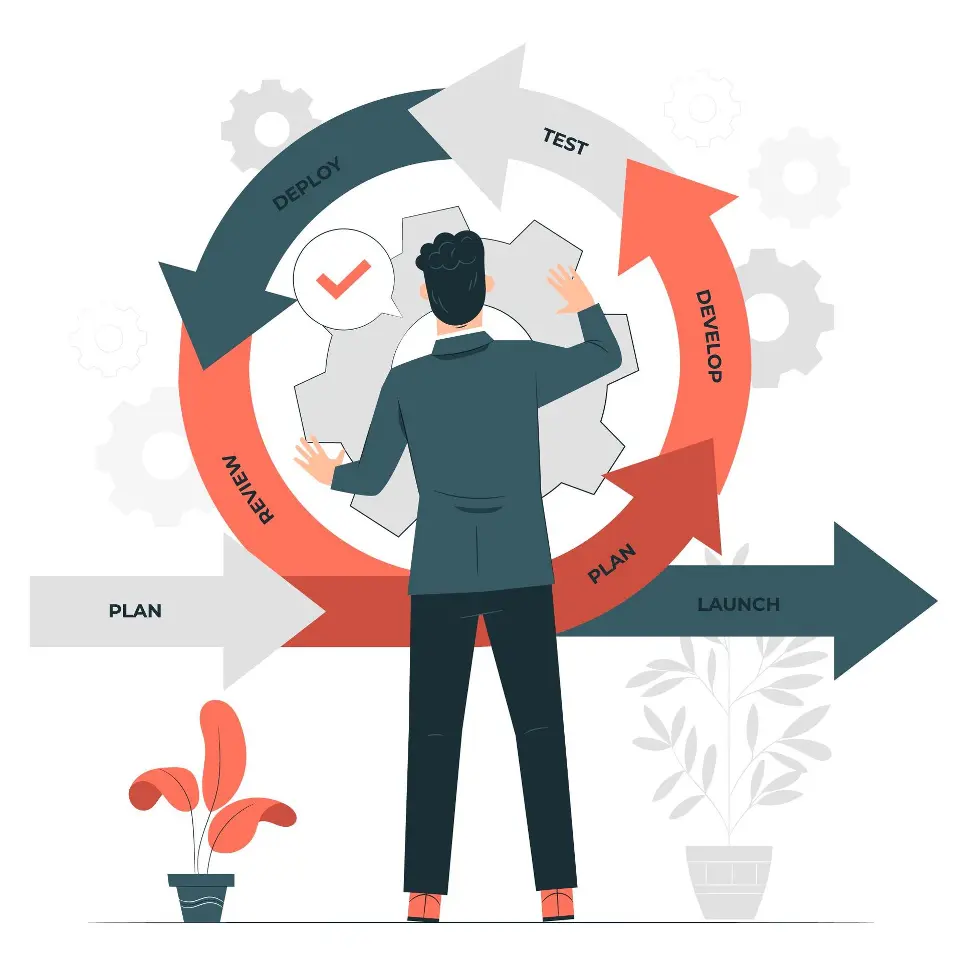Agile Methodology and Its Role in the Software Industry
Agile methodology has become the backbone of modern software development. It is a flexible, iterative approach to project management and product development that emphasizes collaboration, customer feedback, and continuous improvement. The software industry is highly dynamic, with rapidly changing technologies, market demands, and customer expectations, making Agile an ideal methodology to adapt to these challenges. Since its inception in the early 2000s, Agile has reshaped the way software is developed, tested, and delivered, offering more speed, flexibility, and customer satisfaction compared to traditional methodologies like Waterfall.

What is Agile Methodology?
Agile is a set of principles for software development outlined in the Agile Manifesto, which was introduced in 2001 by a group of software developers and project managers. The manifesto emphasizes the following key values:
- Individuals and interactions over processes and tools
- Working software over comprehensive documentation
- Customer collaboration over contract negotiation
- Responding to change over following a plan
Agile methodology is not a single process or framework; instead, it encompasses a range of frameworks, such as Scrum, Kanban, Extreme Programming (XP), and Lean Development, each of which supports the principles of Agile while offering different ways to manage projects and teams.
Key Components of Agile
1. Iterative Development
In Agile, software is developed in small, manageable increments, often called sprints (in Scrum) or iterations. This iterative approach allows for continuous delivery of working software, providing opportunities to test, review, and improve the product regularly. Teams can make changes and adapt to feedback during the development cycle, rather than waiting until the end.
2. Cross-Functional Teams
Agile encourages cross-functional teams composed of developers, testers, designers, and business stakeholders. These teams collaborate closely to ensure that all aspects of product development—coding, testing, designing, and business analysis—are completed in sync. The collaboration leads to faster feedback cycles and ensures that the final product aligns with customer needs.
3. Customer Collaboration and Feedback
One of the primary strengths of Agile is its focus on customer collaboration. By engaging customers and stakeholders throughout the development process, Agile ensures that the product meets real-world requirements. Customer feedback is gathered continuously and used to refine the product incrementally.
4. Continuous Integration and Testing
Agile emphasizes the importance of integrating and testing code regularly. Continuous Integration (CI) tools are often employed to merge code changes into a shared repository several times a day. This practice helps in catching bugs early and ensures that the codebase is always in a deployable state.
5. Self-Organizing Teams
Agile promotes self-organizing teams where individuals are empowered to make decisions. Teams decide how to break down tasks, manage their work, and solve problems without micromanagement. This autonomy improves team morale, fosters innovation, and increases productivity.
6. Adaptive Planning
Rather than following a rigid, long-term plan, Agile supports adaptive planning. Agile teams plan only for the immediate future, adjusting goals and strategies based on the feedback from each iteration. This allows teams to respond quickly to changes in project scope, market conditions, or customer demands.


The Role of Agile in the Software Industry
The software industry is inherently fast-paced and unpredictable, making Agile methodology highly valuable. Here’s how Agile plays a crucial role in transforming software development:
1. Increased Speed and Flexibility
Agile's iterative approach allows development teams to release software faster and more frequently. Traditional Waterfall development required teams to work sequentially, which often led to long delays between the planning phase and the delivery of the final product. Agile breaks down the project into smaller, manageable increments, allowing for quicker releases and more flexibility in adjusting features or timelines as new information becomes available.
2. Higher Product Quality
By integrating continuous testing and review processes into each sprint, Agile ensures that software quality is maintained throughout the development lifecycle. Defects are caught early, reducing the risk of major issues emerging late in the process. Additionally, frequent customer feedback ensures that the product is evolving in the right direction and meets end-user needs, which reduces rework and increases the likelihood of delivering a high-quality product.
3. Improved Customer Satisfaction
In Agile, customers are heavily involved in every stage of development. By delivering working versions of the software regularly, customers can provide immediate feedback on features, design, and functionality. This close collaboration allows for quicker adjustments to meet customer expectations, which ultimately results in higher satisfaction and stronger customer relationships.
4. Enhanced Risk Management
The iterative nature of Agile allows teams to detect risks earlier in the project, providing time to address them before they become major issues. Since the product is continuously tested and reviewed, risks related to technical debt, customer dissatisfaction, and market shifts can be mitigated during development, rather than after the product launch.
5. Greater Team Collaboration and Communication
Agile methodologies prioritize face-to-face communication, whether in person or via digital platforms. Daily stand-up meetings, also known as daily scrums, encourage team members to collaborate, discuss progress, share challenges, and align on the next steps. This real-time communication helps in building strong, cohesive teams and reducing misunderstandings, leading to smoother project execution.
6. Better Alignment with Business Goals
Agile projects are more aligned with evolving business goals because they allow for continuous reevaluation of project priorities. Businesses can pivot and adjust their product roadmap based on changes in the market, new technology, or shifts in customer behavior. Agile's focus on adaptability ensures that software development remains aligned with long-term business strategies, even as those strategies evolve.
7. Cost Efficiency
By delivering features in small increments, Agile allows businesses to evaluate the value of each release before moving on to the next. This incremental delivery reduces the risk of investing heavily in features or products that might not provide sufficient value, enabling companies to allocate resources more effectively. Moreover, identifying and resolving issues early in the development process prevents costly rework down the line.
Agile Frameworks Commonly Used in Software Development
Several Agile frameworks are widely adopted in the software development industry, each offering different approaches to managing projects:
1. Scrum
Scrum is one of the most popular Agile frameworks and is centered around time-boxed iterations called sprints (typically 1-4 weeks). Scrum emphasizes roles such as the Product Owner, Scrum Master, and the Development Team, and uses ceremonies like daily stand-ups, sprint reviews, and retrospectives to keep the team aligned.
2. Kanban
Kanban focuses on visualizing the work process using a Kanban board and limiting the amount of work in progress at any given time. It’s highly flexible, allowing teams to continuously improve their workflow without fixed-length iterations.
3. Extreme Programming (XP)
XP focuses on technical practices to improve software quality and responsiveness to customer requirements. It emphasizes practices like pair programming, test-driven development (TDD), and continuous integration.
4. Lean Software Development
Lean is inspired by lean manufacturing principles and focuses on delivering value to the customer while eliminating waste. Lean aims to increase efficiency by improving workflow and optimizing the use of resources.

Agile’s Impact on Modern Software Industry Trends
Agile has influenced several modern trends in software development:
- DevOps: Agile and DevOps often work together, with DevOps focusing on the continuous delivery and integration of code into production environments. Agile's iterative development pairs well with DevOps' focus on automation and fast feedback loops.
- Cloud Computing: As cloud services enable faster development and scaling, Agile methodologies help teams deliver cloud-native applications more efficiently. Agile frameworks provide the flexibility needed to build, deploy, and improve cloud-based applications continuously.
- AI and Machine Learning: In the AI and ML space, Agile allows data scientists and engineers to iterate quickly on models, test hypotheses, and deliver results in small increments, making it easier to adapt to the complex, uncertain nature of these technologies.
Conclusion
Agile methodology has fundamentally transformed the software industry, offering a flexible, customer-centric approach that improves product quality, team collaboration, and overall project success. Its adaptability, speed, and iterative process allow software teams to deliver valuable products in dynamic and often unpredictable environments. As the software industry continues to evolve, Agile will remain a cornerstone of effective project management, ensuring that businesses can respond to the rapid pace of technological change while meeting customer demands.